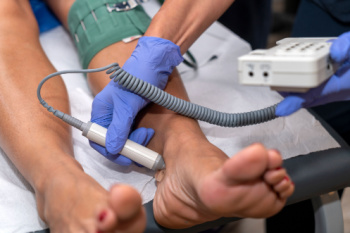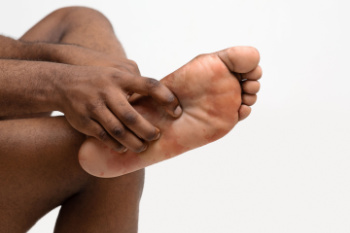February 2024
Stiffness in Child’s Foot and Tarsal Coalition
 Tarsal coalition, the abnormal growth of the tarsal bones in the foot, is generally discovered in children when their bones mature in adolescence. Symptoms include persistent foot or ankle pain, often on the outer side, along with stiffness and restricted range of motion. Children may complain of discomfort during physical activities or sports. Some children develop changes in foot structure, such as a flatfoot or a higher arch. About three to five percent of the population has this condition. A podiatrist can do a comprehensive evaluation of the feet to diagnose the problem, including a medical history assessment, and X-ray diagnostics. These measures can show the podiatrist if there are any abnormal bony connections or fusion between tarsal bones. If your child is experiencing stiff or painful feet, it is suggested you schedule an appointment with a podiatrist for a proper diagnosis and treatment options.
Tarsal coalition, the abnormal growth of the tarsal bones in the foot, is generally discovered in children when their bones mature in adolescence. Symptoms include persistent foot or ankle pain, often on the outer side, along with stiffness and restricted range of motion. Children may complain of discomfort during physical activities or sports. Some children develop changes in foot structure, such as a flatfoot or a higher arch. About three to five percent of the population has this condition. A podiatrist can do a comprehensive evaluation of the feet to diagnose the problem, including a medical history assessment, and X-ray diagnostics. These measures can show the podiatrist if there are any abnormal bony connections or fusion between tarsal bones. If your child is experiencing stiff or painful feet, it is suggested you schedule an appointment with a podiatrist for a proper diagnosis and treatment options.
Some foot conditions may require additional professional care. If you have any concerns, contact Dr. Anna Petrov of Family Foot & Ankle Care. Our doctor can provide the care you need to keep you pain-free and on your feet.
Rare Foot Conditions
The majority of foot conditions are common and can be treated by a podiatrist. Standard diagnostic procedures are generally used to identify specific conditions and treatment can be rendered. A podiatrist also treats rare foot conditions which can be difficult to diagnose and may need extra attention and care.
There are many rare foot conditions that can affect children. Some of these can include:
- Freiberg’s disease
- Kohler’s disease
- Maffucci syndrome
Freiberg’s disease - This can be seen as a deterioration and flattening of a metatarsal bone that exists in the ball of the foot. It typically affects pre-teen and teenage girls, but can affect anyone at any age. Symptoms that can accompany this can be swelling, stiffness, and the patient may limp.
Kohler’s disease - This often targets the bone in the arch of the foot and affects younger boys. It can lead to an interruption of the blood supply which ultimately can lead to bone deterioration. The patient may limp or experience tenderness, swelling, and redness.
Maffucci syndrome - This affects the long bones in a child’s foot leading to the development of abnormal bone lesions. They are benign growths and typically develop in early childhood and the bones may be susceptible to breaking.
A podiatrist can properly diagnose and treat all types of rare foot conditions. If your child is affected by any of these symptoms or conditions, please don’t hesitate to call our office so the correct treatment method can begin.
If you have any questions please feel free to contact one of our offices located in Wheeling and Chicago, IL . We offer the newest diagnostic tools and technology to treat your foot and ankle needs.
Choosing the Ideal Shoes for Restaurant Employees

Selecting appropriate footwear is essential for restaurant employees who spend long hours on their feet, navigating through bustling environments. The best shoes for restaurant workers offer comfort, durability, and slip-resistant features to ensure safety and support throughout demanding shifts. Non-slip shoes with rubber outsoles provide traction on wet and slippery surfaces commonly found in kitchens and dining areas, reducing the risk of slips and falls. Additionally, shoes with cushioned insoles and arch support help alleviate foot fatigue and minimize discomfort during extended periods of standing and walking. Opting for breathable materials like leather or mesh promotes airflow, keeping feet cool and dry in hot and humid environments. It is helpful to choose shoes with closed toes and sturdy construction to protect against spills, dropped objects, and other workplace hazards. If you work in the restaurant environment and are seeking additional information about specific shoes to buy for your working day, it is suggested that you consult a podiatrist.
While working on the feet, it is important to take the proper care of them. For more information about working on your feet, contact Dr. Anna Petrov from Family Foot & Ankle Care. Our doctor will treat your foot and ankle needs.
Working on Your Feet
Standing on your feet for long periods of time can cause stress and pain in your feet. Your whole body may experience change in terms of posture, back pain, bunions, callouses and or plantar warts. There are ways to avoid these conditions with proper foot care, smart choices and correct posture.
Positive Changes
Negative heeled shoe – Choosing this shoe type places the heel slightly lower than the ball of the foot. These are great for overall foot health. Find shoes that fit you correctly.
Go barefoot – Our feet were not designed to be enclosed for all hours of the day. Try to periodically expose your feet to air.
Eliminate Pain
Foot Exercises – Performing simple exercises, incorporating yoga and doing stretches are beneficial. This will allow increased blood flow to the area and muscles of the foot.
Achilles tendon – Stretching the foot out flat on the floor will relax the calf muscles and tendon. These exercises can be performed almost anywhere. Make sure you add these exercises to your daily regimen.
With a little bit of this information and knowing more about foot health, you will notice changes. Foot stretches and proper footwear will help with pain and prevent further issues.
If you have any questions please feel free to contact one of our offices located in Wheeling and Chicago, IL . We offer the newest diagnostic and treatment technologies for all your foot and ankle needs.
Vascular Foot Health Among the Elderly Population

Peripheral arterial disease, also known as PAD, is a condition that happens when your leg arteries become narrow due to a build-up of fat inside them. It can cause pain and weakness in your legs and feet when you walk, but the pain generally dissipates when you rest. Some older people with PAD do not feel any symptoms because they may have other health problems, or their symptoms are not the usual foot and leg pain. Doctors use simple tests to find out if you have PAD. They measure the blood pressure in your ankles and arms and compare them. If the ankle pressure is lower, it means you might have PAD. This condition is more common as people get older, and it is linked to things that can include smoking, diabetes, high blood pressure, and elevated cholesterol levels. If you have peripheral arterial disease and feel pain in your feet and legs, it is suggested that you schedule an appointment with a podiatrist who can perform a proper diagnosis, and guide you toward treatment that can help to improve blood flow.
Proper foot care is something many older adults forget to consider. If you have any concerns about your feet and ankles, contact Dr. Anna Petrov from Family Foot & Ankle Care. Our doctor can provide the care you need to keep you pain-free and on your feet.
The Elderly and Their Feet
As we age we start to notice many changes in our body, but the elder population may not notice them right away. Medical conditions may prevent the elderly to take notice of their foot health right away. Poor vision is a lead contributor to not taking action for the elderly.
Common Conditions
- Neuropathy – can reduce feeling in the feet and can hide many life-threatening medical conditions.
- Reduced flexibility – prevents the ability of proper toenail trimming, and foot cleaning. If left untreated, it may lead to further medical issues.
- Foot sores – amongst the older population can be serious before they are discovered. Some of the problematic conditions they may face are:
- Gouging toenails affecting nearby toe
- Shoes that don’t fit properly
- Pressure sores
- Loss of circulation in legs & feet
- Edema & swelling of feet and ankles
Susceptible Infections
Diabetes and poor circulation can cause general loss of sensitivity over the years, turning a simple cut into a serious issue.
If you have any questions please feel free to contact one of our offices located in Wheeling and Chicago, IL . We offer the newest diagnostic and treatment technologies for all your foot and ankle needs.
How Podiatrists Diagnose Plantar Fasciitis
 Diagnosing plantar fasciitis, an inflammatory condition in the foot which causes heel pain, involves an examination from a podiatrist. A podiatrist may first discuss medical history and symptoms with the patient. Then, this foot doctor will perform a physical examination of the feet, checking for signs such as tenderness in the heel and arch areas. They also check for flat feet, high arches, foot swelling, and tight Achilles tendons. The doctor may also order X-rays or ultrasounds to rule out other potential causes of heel pain. Additionally, during the examination, the podiatrist may assess the range of motion and gait for a comprehensive understanding of the foot mechanics. This combination of methods helps the podiatrist diagnose plantar fasciitis and tailor an effective treatment plan to alleviate pain and promote healing. For an accurate diagnosis and successful management of plantar fasciitis, it is suggested that you schedule an appointment with a podiatrist.
Diagnosing plantar fasciitis, an inflammatory condition in the foot which causes heel pain, involves an examination from a podiatrist. A podiatrist may first discuss medical history and symptoms with the patient. Then, this foot doctor will perform a physical examination of the feet, checking for signs such as tenderness in the heel and arch areas. They also check for flat feet, high arches, foot swelling, and tight Achilles tendons. The doctor may also order X-rays or ultrasounds to rule out other potential causes of heel pain. Additionally, during the examination, the podiatrist may assess the range of motion and gait for a comprehensive understanding of the foot mechanics. This combination of methods helps the podiatrist diagnose plantar fasciitis and tailor an effective treatment plan to alleviate pain and promote healing. For an accurate diagnosis and successful management of plantar fasciitis, it is suggested that you schedule an appointment with a podiatrist.
Plantar fasciitis is a common foot condition that is often caused by a strain injury. If you are experiencing heel pain or symptoms of plantar fasciitis, contact Dr. Anna Petrov from Family Foot & Ankle Care. Our doctor can provide the care you need to keep you pain-free and on your feet.
What Is Plantar Fasciitis?
Plantar fasciitis is one of the most common causes of heel pain. The plantar fascia is a ligament that connects your heel to the front of your foot. When this ligament becomes inflamed, plantar fasciitis is the result. If you have plantar fasciitis you will have a stabbing pain that usually occurs with your first steps in the morning. As the day progresses and you walk around more, this pain will start to disappear, but it will return after long periods of standing or sitting.
What Causes Plantar Fasciitis?
- Excessive running
- Having high arches in your feet
- Other foot issues such as flat feet
- Pregnancy (due to the sudden weight gain)
- Being on your feet very often
There are some risk factors that may make you more likely to develop plantar fasciitis compared to others. The condition most commonly affects adults between the ages of 40 and 60. It also tends to affect people who are obese because the extra pounds result in extra stress being placed on the plantar fascia.
Prevention
- Take good care of your feet – Wear shoes that have good arch support and heel cushioning.
- Maintain a healthy weight
- If you are a runner, alternate running with other sports that won’t cause heel pain
There are a variety of treatment options available for plantar fasciitis along with the pain that accompanies it. Additionally, physical therapy is a very important component in the treatment process. It is important that you meet with your podiatrist to determine which treatment option is best for you.
If you have any questions, please feel free to contact one of our offices located in Wheeling and Chicago, IL . We offer the newest diagnostic and treatment technologies for all your foot care needs.







